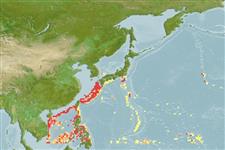Common names from other countries
Elasmobranquios (tiburones y rayas) (sharks and rays) >
Carcharhiniformes (Ground sharks) >
Pentanchidae (Deepwater catsharks)
Etymology: Apristurus: a-, Latin privative, i.e., without; pristis, from pristes (Gr.), sawyer (but here meaning saw); oura (Gr.), tail, referring to absence of saw-toothed crest of enlarged dermal denticles along upper edge of caudal fin as found in the closely related Pristiurus (=Galeus). (See ETYFish); herklotsi: In honor of British botanist-ornithologist Geoffrey Alton Craig Herklots (1902-1986), University of Hong Kong, “with many fond memories of the China Sea and Java”. (See ETYFish).
More on author: Fowler.
Environment: milieu / climate zone / depth range / distribution range
Ecología
marino batidemersal; rango de profundidad 533 - 864 m (Ref. 39445). Deep-water; 36°N - 8°N
Western Pacific: Japan, the Philippines, East and South China seas, and the Kyushu-Palau Ridge.
Tamaño / Peso / Age
Maturity: Lm ? range ? - ? cm
Max length : 48.5 cm TL macho / no sexado; (Ref. 11146)
Espinas dorsales (total) : 0; Espinas anales: 0. Brownish without conspicuous markings (Ref. 244).
A poorly known deep-water bottom shark (Ref. 11146). Oviparous (Ref. 50449).
Life cycle and mating behavior
Maturities | Reproducción | Spawnings | Egg(s) | Fecundities | Larva
Oviparous, paired eggs are laid. Embryos feed solely on yolk (Ref. 50449).
Compagno, L.J.V., 1984. FAO Species Catalogue. Vol. 4. Sharks of the world. An annotated and illustrated catalogue of shark species known to date. Part 2 - Carcharhiniformes. FAO Fish. Synop. 125(4/2):251-655. Rome: FAO. (Ref. 244)
IUCN Red List Status (Ref. 130435)
CITES (Ref. 128078)
Not Evaluated
Threat to humans
Harmless
Human uses
Pesquerías: escaso valor comercial
Herramientas
Special reports
Download XML
Fuentes de Internet
Estimates based on models
Preferred temperature (Ref.
115969): 6.3 - 10.6, mean 7.4 (based on 40 cells).
Phylogenetic diversity index (Ref.
82804): PD
50 = 0.5000 [Uniqueness, from 0.5 = low to 2.0 = high].
Bayesian length-weight: a=0.00355 (0.00176 - 0.00714), b=3.09 (2.91 - 3.27), in cm Total Length, based on LWR estimates for this (Sub)family-body shape (Ref.
93245).
Nivel trófico (Ref.
69278): 3.9 ±0.4 se; based on size and trophs of closest relatives
Resiliencia (Ref.
120179): Muy bajo, población duplicada en un tiempo mínimo superior a 14 años (Fec assumed to be <10).
Fishing Vulnerability (Ref.
59153): Moderate vulnerability (39 of 100).
